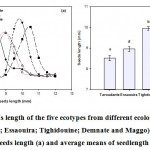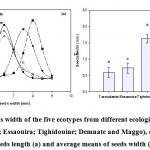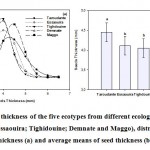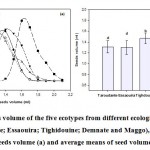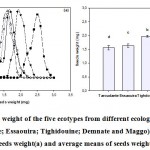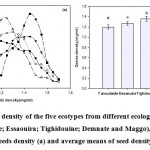How to Cite | Publication History | PlumX Article Matrix
Bioclimatic Impact on the Carob Seeds Morphological Diversity in Morocco
Foughali Boubkar1,2 , Fghire Rachid2,3
, Fghire Rachid2,3 , Anaya Fatima2
, Anaya Fatima2 , Issa Ali Oudou2
, Issa Ali Oudou2 , Tahrouch Saida1
, Tahrouch Saida1 and Wahbi Said2
and Wahbi Said2 .
.
1Laboratoire de Biotechnologie et Physiologie Végétales, Faculté des Sciences,Université Ibn Zohr - Agadir.
2Laboratoire de biotechnologie et physiologie végétales, Faculté des sciences, Université Cadi ayyad- Marrakech
3Département de biologie, Faculté des sciences, Université chouaib doukali- El Jadida.
Corresponding Author E-mail: boubkarfoughali@gmail.com
DOI : http://dx.doi.org/10.13005/bbra/2908
ABSTRACT:
The carob tree, Ceratonia siliqua L., a typical thermophilic sclerophyllous species, is a multipurpose tree (agronomic, silvicultural and pastoral) with aromatic and medicinal properties. Due to its geographical distribution, it occupies different countries of the Mediterranean. In Morocco, this species spreads over the different bioclimatic from the arid in the south to the humid in the north. The present work, study the morphological diversity of the seeds of five carob tree ecotypes distributed along a rainfall gradient (from the arid in the south to the humid one towards the north of the country). The shape parameters studied are the length, width, thickness, weight, volume and density of the seeds.The results obtained show that the carob tree ecotypes are characterized by significant differences in the different morphological parameters of the seeds among the five ecotypes studied. Indeed, dry land seeds are generally reduced in length, volume and weight, while those in humid regions are larger in weight and size. Those of the dry sowing areas have moderate parameters. The variance analysis shows that the origin of the ecotypes hada significant effect on the various shape parameters. Moreover, the multiple comparison of averages revealed different distinct groups. ACP analysis revealed that seed weight and volume is strongly correlated with the first component (the bioclimatic origin and the annual rainfall of the site of origin). While the second component corresponds to the parameters of length, width and thickness of the seeds. As for the factor 3, it corresponds to the density of the seeds which is not dependent on the other variables.In terms of conclusion, it is deduced that in Morocco, the carob tree seeds are characterized by a large morphological diversity which varies according to the rainfall gradient.
KEYWORDS: Carob Trees; Ecotypes; Morphological Diversity; Rainfall Gradient; Seeds
Download this article as:| Copy the following to cite this article: Boubkar F, Rachid F, Fatima A, Oudou I. A, Saadia T, Said W. Bioclimatic Impact on the Carob Seeds Morphological Diversity in Morocco. Biosci Biotech Res Asia 2021;18(1). |
| Copy the following to cite this URL: Boubkar F, Rachid F, Fatima A, Oudou I. A, Saadia T, Said W. Bioclimatic Impact on the Carob Seeds Morphological Diversity in Morocco. Biosci Biotech Res Asia 2021;18(1). Available from: https://bit.ly/2NWzRoO |
Introduction
The carob, Ceratonia siliqua L., is a xerophytic plant that only accommodates hot and arid climates of the subtropical countries 1 . It develops as a sclerophyllous tree and up to 10 m 2. It is one of the most useful indigenous Mediterranean trees 3. Although its origins were once attached to the East and to the Arabian Peninsula 1,3, the distribution of autochthonous carob trees in Mediterranean agro-ecosystems has widely been debated. It occupies spontaneously the different countries of the Mediterranean basin and then spread in America, Asia, Australia and South Africa in regions with a Mediterranean climate3-8. The female or hermaphroditic flower types are the most widely grown and expanded by man through their production9.
It is a multipurpose tree (agronomic, silvicultural and pastoral). Virtually all parts of the tree are useful for humans (leaves, woods, pods, seeds) and have important pharmaceutical and industrial food10. It has been widely exploited since ancient times for food and fodder 3. Extracts of carob tree leaves are rich in active antioxidants that significantly inhibit tumor growth 11. The seeds are of less importance. In fact, their extract revealed medicinal virtues of great importance 12. The foods traditionally used from this fruit, carob flour and carob syrup contain elements of vital importance in the human metabolism necessary for healthier growth and the prevention and cure of diseases. Indeed, they are very rich in protein, crude fiber, mineral elements (Ca, K, Mg, Na, P) and sugars; and they contain low-fat levels compared to some other oilseeds and nuts 13. In addition, carob tree pods showed levels of phenolic compound positively correlated with antioxidant activity 14. The leaves and stem bark of this tree have significant antioxidant activity and higher phenolic content 11
The high content of sugar pulp (sucrose, fructose and glucose) is an economical alternative for the production of lactic acid, which is highly valued and demanded on the industrial market 15. Moreover, given its geographical distribution and the richness of locust beans in carbohydrates, carob trees represent an important potential for the production of lactic acid 16. Thus, the carob tree has aroused in recent years, a very particular interest for manufacturers for its very high content of D-pinitol sugar. Wild trees contain a higher content than cultivated trees 17. The carob tree is also favored by its cultural management, which remains traditional without chemical fertilizers or phytosanitary treatments.
The seed is the richest organ of the tree. All its components (integument, endosperm and cotyledon) play an important industrial and medical role. Gum (endosperm) remains the most important because it is used as a stabilizer, gelling agent, fixer in various fields. Such as food products (cheese, mayonnaise, salads …), cosmetics (creams, toothpastes …), pharmaceuticals (medicines, syrups …), tannins, textiles 18,19. For example, carob pods are considered to be of secondary importance in the carob processing process, whereas seeds are considered the most valuable part of the fruit, containing polysaccharides, which are widely used in the processing of locust beans. Food industry. They therefore constitute an inexpensive source of natural phytochemicals, especially polyphenolic products20.
In Morocco, the carob tree stretches over the plains and the low mountains on a long bio climatic fringe from the arid to the per-humid in the different geographical regions from the Anti-Atlas in the south to the Rif in the north of the country. Its distribution is limited to the thermomediterranean vegetation stage with warm and temperate thermal variants 21. It plays an important socioeconomic role. It generates a total revenue that would be at least 7.94% of the total value of crop production of farmers in the north of the country 22. Because of its adaptability to soil and climate stress, it could contribute to the development of marginal areas with an arid or semi-arid climate, rugged terrain, poor soil, and where specific erosion is high and the regression of the vegetation cover limits any development of these zones. In view of the importance of the carob tree seed, on the one hand, and the diversity of the natural distribution of the carob tree in Morocco, spreading from the arid in the south of the country to the humid North, the present work has set itself the objective of studying the morphological diversity of the seeds of five natural populations of carob trees distributed along a latitudinal and rainfall gradient: from the arid bio climatic in the south of the country, to the wet at north of the country.
Materials and methods
Plant material and its geographical distribution
The present work concerned five ecotypes, carob trees in Morocco distributed according to an aridity gradient based on average annual rainfall and bio climatic stages. These provenances are spread over bioclimatic ranging from the arid south of the Western High Atlas to the humid western Rif 23. The ecotypes studied are:
P1 : Taroudante on the southern slope of the high western atlas (arid bioclimaticwith a warm winter);
P2 : Essaouira on the west coast of the high western atlas (semi-arid bioclimaticwith a warm winter);
P3 : Tighdouine on the northern slope of the high central atlas (semi-arid bioclimatic inferior with a cool winter);
P4 :Demnate in the center of the country (semi-arid bioclimatic superior with a cool winter);
P5 : Maggo at the Western Rif (wet bioclimatic with a cool winter).
Table 1: Climatic characteristics of the provenances studied:
|
Ecotypes |
rainfall (mm/year) | Bioclimate | Tranche altitudinale (m) |
Localisation GPS |
| Taroudant | 226 | arid with a warm winter | 200 – 300 | 30,470°N 8,877°W |
| Essaouira | 285 | semi-arid with a warm winter | 0 – 50 | 31,513°N 9,770° W |
| Tighdouine | 380 | semi-arid inferior with a cool winter | 1000 – 1100 | 31.428°N 7.525W |
| Demnate | 475 | semi-arid superior with a cool winter | 1000 – 1100 | 31,734°N 7,005°W |
| Maggo | 880 | wet with a cool winter | 600 – 700 | 35.186N 5.285W |
The collected pods were thoroughly mixed and then crushed and sieved to obtain a perfect mix of seeds. For each ecotype, shape parameter measurements were performed on one thousand (1000) seeds selected in a completely random fashion.
Parameters studied
The seeds of the five provenances were a subject of different measurements to study the morphological variation using the different shape parameters, namely:
Length (mm) ;
Width (mm) ;
thickness (mm);
volume (ml),
weight (mg) ;
Seed density (mg / ml).
Statistical data processing tools
Descriptive analysis of the variables studied.
Development of the distribution curves (frequencies) of the observations.
Analysis of the variance (ANOVA1) (effect of origin on the measured parameters); and comparison of averages (Tukey test, etc.)
Software used: IBM SPSS statistics 20 & sigma Plot 11.0
Methods of statistical processing of data
The samples were extracted from totally independent populations
Measured seeds were chosen at each source in a completely random manner
After checking the normality test and the equality test for variances at (P <0.050), the measured data were statistically processed by ANOVA 1 (effect of origin on the different shape parameters measured).
The verification of the significance of the F. test in the ANOVA results table1, allows us to conclude whether there is a relationship between the measured parameters and their geographical origin.
In the case of confirmation of an effect relationship, we determine at which level the statistically significant differences between these provenances are found by using the average comparison test of all the provenances studied.
The method used in the comparison test of averages is the Tukey test given the large size of our samples and that they are the same size for all provenances.
Results
Table 2 below summarizes the statistical descriptions (mean and coefficient of variation) of the seed shape parameters of the five carob tree provenances studied (length, width, thickness, weight, volume and density of seeds).
The reading of this table shows that globally the seeds of the five provenances studied are not all homogeneous from the morphological point of view. Indeed, we note that morphological parameters, seeds from each source, show a certain trend (expressed on average) that seems to vary from one source to another. Similarly, for all the measured parameters, there is variability within each source. This variability is expressed by the values of the coefficients of variation (CV).
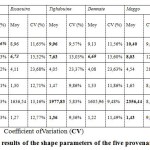 |
Table 2: Statistical results of the shape parameters of the five provenances of carob. |
To better understand the variability observed between and within provenances, we carried out the various statistical treatments of the measured data of the various seed shape parameters.
Table 3: One-Way ANOVA Analysis of the effect of provenance on the Morphological Parameters.
| ddl | F | Signification | |
| Seed length | 4 | 545,812 | ,000 |
| Seed width | 4 | 415,581 | ,000 |
| seed thickness | 4 | 54,180 | ,000 |
| seed volume | 4 | 1005,248 | ,000 |
| seed weight | 4 | 3146,555 | ,000 |
|
seed density |
4 | 405,636 |
,000 |
Seed length
Figure 1.a shows that the seeds of the five-carob ecotypes studied are characterized by a length that ranges from 7 to 12 mm. This distribution curve illustrates an almost marked differentiation between the five ecotypes.
As illustrated by the figure 1.b, the arithmetic means of seed length was very differentiated depending on the ecotypes.The seeds of Maggo had the greatest length; followed respectively by those of Tighdouine, Demnate and Essaouira; while those of Taroudante are the shortest although they are characterized by the widest spectrum of variability with the highest CV (Table 2).
Statistical analysis (table 3) show that provenance had a very high significance (p<0.001) effect on the seeds length. This allows us to conclude that there is a relationship between seed length and geographical origin. This means that seed length differs from at least one ecotype compared to other ecotypes.
Means comparison of seeds length using the Tukey test was apllicated to all the provenances to determine at what level the statistically significant differences between these provenances are. Reading the results illustrated in figure 1.b, it can be deduced that the five ecotypes studied stand out from each other at a threshold of (P <0.010). This means that each source is a separate group and they are completely separate from each other.
Width of the seeds
Reading the figure 2.a and 2.b below shows that from the point of view of the width, the seeds of Taroudante are of the smallest width, and they are relatively similar to those of Demnate
and Essaouira. The seeds of Maggo present the big width followed by those of Tighdouine. Considering CV values (Table 2), seed width has a wide range of variability (higher CVs) compared to seed length variability.
The results of the statistical analysis (table 3) showed that the effect of provenance is very highly significant (P <0.001) on seed width. It is deduced that at least one group is different from the others in terms of seed width.
In addition, the Tukey test confirmed that the width of the seeds of Taroudante is similar to that of Demnate and therefore constitute a single homogeneous group. Similarly, Essaouira seed width is similar to that of Demnate at the P <0.010 level. While the Tighdouine and Maggo ecotypes are significantly distinct from one another, and they are different from the other groups.
Thickness of the Seeds
Table 2 shows that carob seeds are highly heterogeneous from the point of view of the thickness since the CV exceeds 20% for all ecotypes.The distribution curve of the seeds according to their thickness (figure 3.a) as well as the diagram of the average width (figure 3.b) show that the seeds of Maggo and Taroudante have a great thickness, whereas the seeds of Essaouira, Tighdouine and Demnate are less thick.
Statistical analysis (table 2) showed a very highly significant (p<0.001) effect of seeds origin on their thickness. This says that at least one group is different from the others in terms of seed thickness.The Tukey comparison test of the average P <0.010 thresholds showed two distinct groups of provenances. The first group consists of Tighdouine, Essaouira and Demnate, and the second group contains Maggo and Taroudante (figure 3.b)
Seed Volume
From the point of view of seed volume, we can see in Table 2 that the carob seeds show heterogeneity between the five provenances studied. Similarly, within each provenance there is some variability.The distribution curve of the seeds according to their volume (figure 4.a) as well as the diagram of the average width (figure 4.b) show that the seeds of Maggo and Tighdouine are larger, whereas the seeds of Tarourante Essaouira and Demnate are relatively less volume.
Statistical analysis showed a very highly significant (P <0.001) effect of seed origin on their volume (Table 3).To better understand the results of the above-mentioned, we performed Tukey’s comparison of volume averages at the P <0.010 threshold. The results obtained (figure 4.b) show that in terms of volume, the seeds of Essaouira and Taroudante are homogeneous and therefore constitute a single group, while the other three ecotypes (Maggo, Demnate and Tighdouine) are distinguished from each other and therefore each constitute a separate group.
Seed Weight
From Table 2 and Figure 5, seed weight appears to have the same trend as seed volume. In fact, the heaviest seeds are from provenances of Tighdouine and Maggo whereas the seeds of the provenances of Taroudante, Essaouira and Demnate shows the lowest weight. terms of weight. The results obtained (figure 5.b) show that all provenances differ from one another in terms of seed weight at the P <0.010 threshold.
Density of Seeds
Figure 6 shows that the average seed density of the ecotypes studied differs from one source to another. Seed density seems to follow the same trends in seed weight. Indeed, the seeds of the provenances of Maggo and Tighdouine are of greater density whereas the seeds of Taroudante, Demnate and Essaouira are relatively less dense.
The results of ANOVA 1 (Table 3) showed that the effect of provenance is very highly significant (P <0.001), on the seed density.Tukey’s comparison of seed density averages showed that the density of Taroudante and Demnate seeds are similar and therefore constitute a single homogeneous group. While, the averages of the density of the seeds of Essaouira, Tighdouine and Maggo are significantly distinct from each other.They therefore constitute different groups.
Correlation and ACP Analysis
Table 4 shows different correlations between studied parameters and geographical parameters, with the exception of the seed density, which has no significant correlation with other seed shape parameters (length, width, thickness, volume and weight) or geographic (altitude, rainfall) and bioclimatic parameters.All other morphological parameters show a very high significance (p<0.001) within them and with the geographical parameters. However, the thickness shows a lower significance (p<0.01) with the geographical parameters, and a negative correlation with the altitude. Therefore, as the rainfall and altitude increased the all the morphological paramthères will be increased except the thickness.
Rainfall and bioclimatic, mutually and naturally correlated in a very highly significant (p<0.001) manner, have a highly significant correlation to the length, width, weight and volume of the carob seed studied.
Table 4: Pearson correlation coefficient of morphological and geographical parameters of seeds of fivegenotype of carob tree.
| Parameters | Length | Width | thickness | weight | Volume | Density | Rainfall | Altitude | Bioclimat |
| Length | 1 | 0,878** | 0,696** | 0,474** | 0,316** | 0,038 ns | 0,454** | 0,287** | 0,414** |
| Width | 1 | 0,758** | 0,422** | 0,278** | 0,036ns | 0,391** | 0,204** | 0,319** | |
| thichness | 1 | 0,006ns | 0,003ns | 0,093ns | 0,096* | -0,068* | 0,041* | ||
| weight | 1 | 0,721** | 0,063ns | 0,730** | 0,266* | 0,604** | |||
| Volume | 1 | -0,033ns | 0,595** | 0,237* | 0,489** | ||||
| Density | 1 | 0,038 ns | 0,139ns | 0,032ns | |||||
| Rainfall | 1 | 0,364** | 0,941*** | ||||||
| Altitude | 1 | 0,421** | |||||||
| Bioclimat | 1 |
The correlation is very highly significant at the 0.001 level.
The correlation is highly significant at the 0.01 level.
The correlation is significant at the 0.05 level.
ns. No significance
The principal component analysis of the data revealed 9 components including the 3 main components that express about 80% of the data variability (figure 7). These two diagrams as well present the components extracted by PCA and the matrix of components show that the first component alone accounts for almost half of the variability (47.13%)of the data. This factor is composed mainly of the rainfall, the weight of the seeds, the bioclimatic, the length, the width and the volume of the seeds, which contributes positively to the constitution of this component. While component 2 (21.28%) consists mainly of shape parameters (thickness, length and width of seeds). The third component constructed mainly by the density of seeds and present just 11.63% of variability.
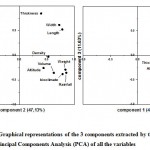 |
Figure 7: Graphical representations of the 3 components extracted by the Principal Components Analysis (PCA) of all the variables. |
Discussion
The results obtained show that the seeds from the most arid zone (from Taroudante with an average annual rainfall of 226 mm / year) located on the southern slope of the high western atlas, have the lowest form parameters compared to the others. For provenances from relatively more watered areas. Indeed, the seeds of Taroudante are of the smallest size with the average of length, width, weight and volume respectively of the order of 8,52 ± 1,14 mm, 6,59 ± 1,00 ml, 0,156 ± 0.250g and 1.31 ± 0.15ml. These results are similar to the results of the work carried out for the provenance of Ait Berrehil, also located on the southern slope of the high western atlas but also for the provenances of Issafen and Tafraoute, located in the anti atlas, in an arid bioclimatic reported by Sidina, et al. 5.
The observed effect of aridity on the length of carob seeds was also reported in the results of the work carried out in Tunisia, for example the population of Chbika 24. In addition, the worksdone by Konaté, et al. 4and by Turnbull, et al. 25, on the weight of carob seeds showed similar results.
On the other hand, the seeds coming from humid bioclimatic provenances of the north of the country, case of Maggo in particular where the highaverage annual precipitation is of the order of 880 mm /year, are of the largest size. Indeed, the average size of the seeds of Maggo is of the order of 10.40 ± 1.00mm, 8.03 ± 1.00ml, 0.236 ± 0.019g and 1.65 ± 0.14ml respectively for the length, the width, weight and volume of the seeds. These results were also observed for carob seeds from other sources in humid regions of Morocco5,26. The results obtained for these parameters (length, width and weight of the seeds) are comparable to the results observed in Spain 27.
In this sense, we find that the two ecotypes of the arid region and the humid region are always opposed in the different groups released by the comparison of the averages of the set of parameters (variables) of shape of the seeds.
This finding was confirmed for all the ecotypes studied by calculating the Pearson correlation coefficient of the morphological parameters of the seeds studied and the geographical parameters of the origin of their ecotypes (Table 3). In fact, this table shows that with the exception of the density of the seeds, which has no correlation with the other seed shape parameters (length, width, thickness, volume and weight) nor with the parameters of the geographical origin (altitude rainfall and bioclimatic), rainfall and bioclimatic, mutually and naturally correlated in a very highly significant way, have a highly significant correlation to the length, width, weight and volume of the carob seed studied. That said, the size of the natural carob tree seeds follows the annual rainfall gradient or their size depends on the degree of aridity of the climate of the site of their origin. Seed thickness shows indifference to environmental factors. This result was also reportedin work done in Spain 27.
If the genetic heterogeneity is assumed ascertained by Sidina, et al. 5, we can deduce that this is a kind of adaptation of the species to severe rainfall conditions. This is explained by the independence of the density (ratio of weight to seed volume) to the other geographical and shape parameters, on the one hand, and by the low effect of altitude on these parameters.On the other hand, the three seed shape parameters used in the mathematical formulas for measuring the volume of carob seeds 28, namely: length, width and thickness, both determine the volume and the weight of the seeds of all the ecotypes studied. Similarly, the length and width of seeds that determine their weight and volume since the thickness is not correlated with them. Thus, the contribution of the thickness in the volume and the weight of the seeds are minimal.
According to the PCA analysis, we can once again confirm that the size of the carob seeds (length, width, weight and volume) depends on their geographical origin (rainfall and bioclimatic). In fact, these highly positively correlated variables are distinguished together in component 1. As for component 2, it groups together the three shape parameters (length, width and thickness) that mathematically determine both the volume and the weight of the seeds. While component 3 mainly represents seed density which is independent of other parameters morphological and geographical site.
Conclusion
In terms of conclusion, it is deduced that in Morocco the seeds of the carob tree are characterized by a great morphological diversity. This variability is found in all the measured parameters.If this variability was also observed within each ecotype, with the apparent existence of a general trend in the data around a given average (unimodal frequency distribution by class of the variable), these distributions show highly contrasting variability between the different ecotypes practically for all the variables.
Statistical treatments by ANOVA1 have shown the existence of an effect of provenance on the different variables. The multiple comparison of averages made it possible to identify the different homogeneous groups for each variable. In all the cases found, the seeds of moist bio climatic (Maggo from the north of the country) provenances, which are larger and heavier, are distinguished from those of the arid and semi-arid bio climatic zones of the south of the country (Taroudante and Demnate).The weight and volume of carob seeds are based on the main shape parameters, length and width. These are closely related to rainfall and bio climatic.It is thus deduced that the size of the natural carob tree seeds depends on the rainfall and the bio climatic of their original site
Acknowledgment
Authors thanks the universities.
Conflict of interest
Authors declare no conflict of interest.
Funding source
This ressearch was funded by the loboratorys source.
References
- Evreinoff, V. A. Le Caroubier ou Ceratonia siliqua L. Revue internationale de botanique appliquée et d’agriculture tropicale (1947); 27(299): 389-401.
CrossRef - Neville-Rolfe, E. Carob Tree. (Ceratonia Siliqua, L.). Bulletin of Miscellaneous Information (Royal Gardens, Kew) (1898); 1898(140).
CrossRef - Battle, I. & Tous, J. Carob tree: Ceratonia siliqua L.-Promoting the conservation and use of underutilized and neglected crops. 17. Bioversity International, 1997.
- Konaté, I., Filali-Maltouf, A. & Berraho, E. B. Diversity analysis of Moroccan carob (” Ceratonia siliqua” L.) accessions using phenotypic traits and RAPD markers. (2007).
CrossRef - Sidina, M. M. et al. Fruit and seed diversity of domesticated carob (Ceratonia siliqua L.) in Morocco. Scientia Horticulturae (2009); 123(1): 110-116.
CrossRef - Gharnit, N. & Ennabili, A. Categories of Carob Tree (Ceratonia siliquaL.) from Morocco. International Journal of Fruit Science (2015); 16(3): 259-274.
CrossRef - Gharnit, N. & Ennabili, A. J. B. E. Essais préliminaires de culture in vitro du caroubier (Ceratonia siliqua L.) originaire du Nord ouest du Maroc. (2009); 3(6): 18-25.
- Winer, N. The Potential of the Carob(Ceratonia Siliqua). International Tree Crops Journal (1980); 1(1): 15-26.
CrossRef - Hills, L. D. The Cultivation of the Carob Tree(Ceratonia Siliqua). International Tree Crops Journal (1980); 1(1): 27-36.
CrossRef - El Kahkahi, R. et al. Technical sheet on the culture carob tree (Ceratonia Siliqua L.) in Morocco. (2016).
- Custódio, L. et al. Antioxidant activity andin vitroinhibition of tumor cell growth by leaf extracts from the carob tree (Ceratonia siliqua). Biol. (2009); 47(8): 721-728.
CrossRef - Teillet, B., Colin, M., Armengol, J. & Prigent, A. J. P. d. è. j. s. l. r. c. Effet d’un extrait de graines de caroube partiellement décortiquées sur les performances de viabilité et de croissance chez le lapin. (2011): 22-23.
- Ozcan, M. M., Arslan, D. & Gokcalik, H. Some compositional properties and mineral contents of carob (Ceratonia siliqua) fruit, flour and syrup. J. Food Sci. Nutr. (2007); 58(8): 652-658.
CrossRef - Benchikh, Y. & Louailèche, H. Effects of extraction conditions on the recovery of phenolic compounds andin vitroantioxidant activity of carob (Ceratonia siliquaL.) pulp. Acta Bot. Gallica (2014); 161(2): 175-181.
CrossRef - Hariri, A., Ouis, N. & Bouhadi, D. Effect of the Alternative Addition of Sodium Acetate and Tween 80 on the Production Curve of Lactic Acid by Lactobacillus Casei Subsp Rhamnosus from date variety Hmira and carob pods syrups. J SciFed Journal of Chemical Research (2017); 1(1).
- OUIS, N. & HARIRI, A. Improving of lactic acid production by Lactobacillus plantarum from carob pods syrup. wulfenia journal (2018); 25( 7): 12-25.
CrossRef - Turhan, I. Relationship Between Sugar Profile and D-Pinitol Content of Pods of Wild and Cultivated Types of Carob Bean (Ceratonia siliqua L.). J. Food Prop. (2013); 17(2): 363-370.
CrossRef - Dakia, P. A., Wathelet, B. & Paquot, M. Isolation and chemical evaluation of carob (Ceratonia siliqua L.) seed germ. Food Chem. (2007); 102(4): 1368-1374.
CrossRef - Biner, B., Gubbuk, H., Karhan, M., Aksu, M. & Pekmezci, M. Sugar profiles of the pods of cultivated and wild types of carob bean (Ceratonia siliqua L.) in Turkey. Food Chem. (2007); 100(4): 1453-1455.
CrossRef - Makris, D. P. & Kefalas, P. Carob pods (Ceratonia siliqua L.) as a source of polyphenolic antioxidants. J Food Technology (2004); 42(2): 105-108.
- Benabid, A. Flore et écosystèmes du Maroc: Evaluation et préservation de la biodiversité. (2000).
- Gharnit, N., El Mtili, N., Ennabili, A. & Sayah, F. J. T. B. B. d. D. N. d. l. F. d. F. B. importance socioéconomique du caroubier (Ceratonia siliqua L.) dans la Province de Chefchaouen (nord-ouest du Maroc), Rev. (2006); 4(33).
- Mokhtari, N., MRABET, R., LEBAILLY, P. & Laurent, B. J. R. M. d. S. A. e. V. Spatialisation des bioclimats, de l’aridité et des étages de végétation du Maroc. (2014); 2(1): 50-66.
- Naghmouchi, S., Khouja, M. L., Romero, A., Tous, J. & Boussaid, M. Tunisian carob (Ceratonia siliqua L.) populations: Morphological variability of pods and kernel. Scientia Horticulturae (2009); 121(2): 125-130.
CrossRef - Turnbull, L. A., Santamaria, L., Martorell, T., Rallo, J. & Hector, A. Seed size variability: from carob to carats. Lett. (2006); 2(3): 397-400.
CrossRef - El Kahkahi, R., Zouhair, R., Ait Chitt, M. & Errakhi, R. J. I. J. P. A. B. Morocco carob (Ceratonia siliqua L.) populations: Morphological variability of Pods and Kernel. (2014); 2(4): 38-47.
- Albanell, E., Caja, G. & Plaixats, J. CHARACTERIZATION OF CAROB FRUITS (Ceratonia siliqua L.), CULTIVATED IN SPAIN FOR AGROINDUSTRIAL USE. International Tree Crops Journal (1996); 9(1): 1-9.
CrossRef - Benkovic, M. et al. Assessment of Drying Characteristics and Texture in Relation with Micromorphological Traits of Carob (Ceratonia silliqua L.) Pods and Seeds. Food Technol. Biotechnol. (2016); 54(4): 432-440.
CrossRef

This work is licensed under a Creative Commons Attribution 4.0 International License.



